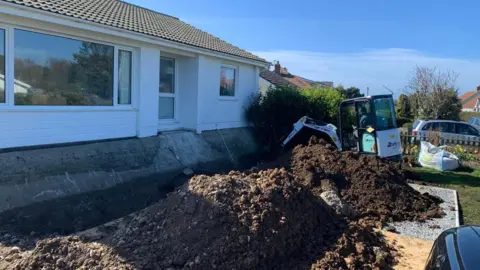In a surprising historical discovery, a couple in Guernsey, Shaun and Carrie Tullier, recently unearthed a World War II German bunker beneath their home. Their home, located in the Torteval area, was initially purchased four years ago, with the couple aware that it was situated on the site of a German gun emplacement. The couple, driven by curiosity and a tip from a former inhabitant regarding a potential bunker beneath the property, embarked on a significant digging project under their driveway.
The undertaking led them to discover a well-structured wartime bunker that had remained hidden for decades. Initially intended to serve merely as a renovation project and perhaps a recreational space, the couple is enthusiastic about preserving the historical aspects of the bunker while also planning for its transformation into a games room and gym area. The couple’s decision to investigate was fueled by the historical significance of their home, a sentiment that seems deeply rooted in the local community.
Guernsey had a tumultuous wartime history, being occupied by German forces from 1940 to 1945 under Adolf Hitler’s directive to create an “impregnable fortress.” The occupation resulted in significant hardships for the local population, with many deported and others facing dire food shortages. Liberation Day is now celebrated on May 9, marking the end of Nazi rule in the region, a memory cherished by the islanders. This historical context adds immense value to the Tulliers’ discovery, transforming a property renovation into an exploration of the island’s complex past.
The Tulliers’ journey into the ground revealed substantial evidence of the bunker’s wartime use. Upon digging deeper, Shaun Tullier recounted that they eventually struck a doorway leading into the bunker, a moment he described with amazement. Inside, they found two rooms measuring approximately 17ft by 10ft and 17ft by 20ft, featuring elements such as a tiled floor, an escape hatch, and German inscriptions on the walls warning of potential enemy surveillance. One of the inscriptions, “Achtung feind hort mit,” translates to “beware, the enemy is listening,” emphasizing the bunker’s intended purpose.
Amidst their excavations, the couple discovered various discarded military items, including tins and remnants of the past, contributing to the rich narrative of the structure. The bunker, they noted, had been sealed since the 1960s, yet it remained remarkably intact, displaying the quality of construction typical for such military structures.
Mr. Tullier mentioned that another major task post-discovery involves pumping out water that had accumulated inside the bunker over the years. However, he expressed satisfaction with its overall condition. The couple’s vision encompasses creating a recreational space while simultaneously inviting visitors keen on exploring the local history. They feel a sense of responsibility to maintain and showcase the German elements, turning their private discovery into a shared historical narrative.
This sentiment reflects broader community values about remembering the past—an acknowledgment of the darker times that once enveloped Guernsey but also an effort to ensure that history serves as a lesson for future generations. Tullier emphasized his fascination with the historical elements, advocating for a balance between modern usage and historical reverence. In doing so, the couple’s story transcends that of a simple home renovation, evolving into a reflection of how the remnants of history can shape contemporary lives and fortify connections to the past.
So, as Shaun and Carrie Tullier navigate renovations of their newfound bunker, they embrace both the burdens of history and the joys of discovery, intertwining their personal lives with the legacy of World War II in Guernsey—a poignant reminder of resilience and remembrance that continues to inform the island’s cultural identity today.












